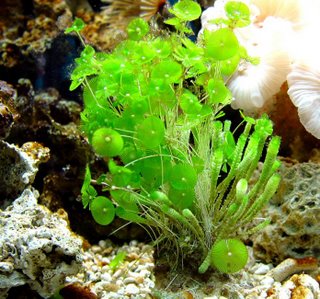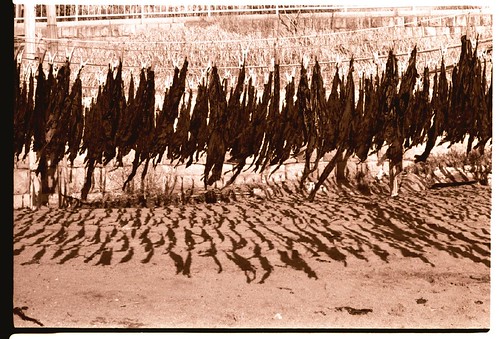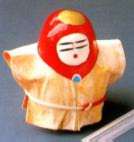:::::::::::::::::::::::::::::::::::::::::::::::::::::::::::::::::::::::::::::::::::::::::::::::::::::
Seaweed (kaisoo 海草) and waterweeds (mo)
***** Location: Japan, worldwide
***** Season: Various, see below
***** Category: Plant / humanity
*****************************Explanation
The word "seaweed (kaisoo 海藻)" itself is not a kigo and can be used all year for haiku.
There are however some kigo with individual kinds of seaweed.
Seaweeds are a daily ingredient in Japanese food.

http://home.h03.itscom.net/takagi/sango.files/Kaisou.htm
**********************************
Kigo for SPRING
laver, sea lettuce, nori 海苔
kigo for early spring
. Dishes with Nori - WASHOKU .

..... Porphyra tenera
to dry laver, nori hosu 海苔干す
dried laver, hoshinori 干海苔
sweet laver, amanori 甘海苔(あまのり)
. laver from Asakusa, Asakusa nori 浅草海苔(あさくさのり) .
laver from Kasai, Kasai nori 葛西海苔(かさいのり)
laver sheets to eat, nori hibi 海苔篊(のりひび)
bamboo poles to grow seaweed among, nori soda 海苔粗朶(のりそだ)
floating seaweed, nagarenori 流海苔(ながれのり)
picking up seaweed, hiroi nori拾い海苔(ひろいのり)
board to dry seaweed 海苔砧(のりきぬた)、norisu 海苔簀(のりす)
susabi nori すさび海苔(すさびのり)
Nori from Uppuri Island, uppurui nori 十六島海苔(うっぷるいのり)
boat to harvest laver, noribune 海苔舟
gathering laver, harvesting laver, nori tori 海苔採
harvesting nori seeweeds, nori toru 海苔採る(のりとる)
... ... ...
"rock laver", iwa nori 岩海苔 いわのり
kigo for early spring

..... iwanori 岩海苔 (いわのり)
..... kaifu nori 海府海苔(かいふのり)
They are picked from the rocks and cliffs by hand when the tide receedes and are quite expensive.
"hair of the sea", ugo 海髪 うご
a kind of red seaweed, igisu
..... ogo おご、ogo nori 江籬(おごのり)、ugo nori うごのり、nagoya なごや
Gracilaria verrucosa
white seaweed (duckweed), shiramo 白藻 しらも..... tsurushiramo 蔓白藻(つるしらも)、oo ogonori おおおごのり
green seaweed, aonori 青海苔
..... ito aosa いとあおさ、naga aonori 長青海苔(ながあおのり)、sasanori 笹海苔(ささのり)、usuba aonori 薄葉あおのり(うすばあおのり)、hito-e gusa ひとえぐさ
aosa 石蒪 (あおさ)
fam. Enteromorpha
"cherry blossom seaweed" sakuranori 桜海苔 (さくらのり)
..... mukade nori むかで海苔(むかでのり)
Okitsu nori 興津海苔(おきつのり)nori from Okitsu island
"pine seaweed" matsu nori 松海苔 (まつのり)
..... pine needle seaweed, matsuba nori 松葉海苔(まつばのり)、tenboso てんぼそ
... ... ...
kelp, wakame, 若布, 和布
..... Undaria pinnatifida

nigime にぎめ
menoha め‐の‐は【海布葉】
boat for harvesting kelp, wakamekaribune 若布刈舟
harvesting wakame seeweeds, wakame karu
若布刈る (わかめかる)
wakame toru 若布採る(わかめとる)
..... wakamegari 若布刈(わかめがり)、mekari めかり
wakamezao 若布刈竿(めかりざお)pole for harvesting wakame
. wakamekarigama 若布刈鎌(わかめかりがま)
sickle to cut wakame seaweed
drying seeweeds, wakame hosu 若布干す(わかめほす)

Photo Gabi Greve, 1993
drying seaweed -
these dancing shadows
on the sand
© Gabi Greve, with more photos !
wakameuri, wakame uri 若布売(わかめうり)vendor of wakame
wakamejiru 若布汁(わかめじる)soup with wakame
mekabu tororo めかぶとろろ tororo with wakame
Naruto wakame 鳴門若布(なるとわかめ)wakame from Naruto, Shikoku
Nanbu wakame 南部若布(なんぶわかめ)wakame from Nanbu (now Iwate coast)
Izumo wakame 出雲若布(いずもわかめ)wakame from Izumo
kajime 搗布 かじめ Kajime algae
Ecklonia cava Kjellman, Art Braunalge
..... hitotsubane ひとつばね、sagarame さがらめ
kajime karu 搗布刈る(かじめかる)harvesting kajime
搗布舟(かじめぶね) boat for harvesting kajime
kajime hosu 搗布干す(かじめほす)drying kajime
kurome 黒布 (くろめ) "black seaweed"
a kind of konbu
...............................................
hijiki 鹿尾菜 (ひじき) Hijiki, edible brown algae
Hizikia fusiformis. essbare braune Meeresalge
..... 鹿角菜(ひじき)、羊栖菜(ひじき)、
hijikimo ひじき藻(ひじきも)- fukuro hijiki ふくろひじき
drying hijiki seaweed, hijiki hosu ひじき干す(ひじきほす)
miru 海松 (みる) "pine of the sea"
Codium fragile Hariot. Meergewei
mirume みるめ、mirubusa 海松房(みるぶさ)
harvesting mirume seaweed, mirume karu みるめ刈る(みるめかる)
tsunomata 角叉 (つのまた) tsunomate red algae
Chondrus ocellatus. Rotalgenart
tsunomata hosu 角叉干す(つのまたほす)drying tsunomata
ooba tsunomata おおばつのまた、komata こまた
. mozuku もずく(水雲/海蘊) .
Nemacystis decipiens
.................................................................................
kigo for late spring
arame 荒布 (あらめ) arame seaweed
lat.: Eisenia bicyclis
shwakajime 皺搗布(しわかじめ)
futamata kajime 二叉搗布(ふたまたかじめ)、matakajime またかじめ
aramebune 荒布舟(あらめぶね) boat for harvesting arame
arame karu 荒布刈る(あらめかる)harvesting arame
arame hosu 荒布干す(あらめほす)drying arame
harvesting arame seaweed, arame karu 荒布刈る(あらめかる)
...............................................
observance kigo for early spring
. Maya konbu 摩耶昆布(まやこんぶ)Maya kelp
For the Maya Temple Visit, dedicated to Maya, Mother of Shakyamuni Buddha
**********************************
Kigo for SUMMER
. Suizenji-nori 水前寺のり
from Kumamoto and Fukuoka, Kyushu
. . . . . also
egonori 恵古苔 (えごのり) egonori laver
egoten えごてん
ego konnyaku えごこんにゃく
okiuto おきうと "okiuto weed"
Campylaephora
.................................................................................
tengusa 天草 (てんぐさ) agar-agar
tokorotengusa ところてん草(ところてんぐさ)
Gelidium amansii
gathering agar agar, tengusa tori 天草採り
..... tengusa 天草取る(てんぐさとる)
tengusa toru 天花菜取る(てんぐさとる)
tokorotengusa toru 心太草取る(ところてんぐさとる)
tengusa hosu 天草干す(てんぐさほす)drying tengusa
. . . . . and
. Jelly Strips, gelidium jelly (tokoroten)
.................................................................................
dulse seaweed, red algae (Palmaria palmata) ダルス
North America

. . . . .
konbu kari 昆布刈 (こんぶかり)kombu kelp harvest
konbu karu 昆布刈る(こんぶかる)harvesting kombu
..... konbu toru 昆布採る(こんぶとる)
konbu hosu 昆布干す(こんぶほす) drying konbu kelp
konbu 昆布 (こんぶ) kombu kelp
plant kigo for late summer
.................................................................................
humanity kigo for late summer
. cutting duckweed, mo kari 藻刈り
mo karu 藻刈る(もかる)waterweeds harvest
and more related kigo
funori hoshi 海蘿干 (ふのりほし) drying funori red algae
funori hosu 海蘿干す(ふのりほす)drying funori
funori kaki 海蘿掻(ふのりかき)collecting funori
Gloiopeltis frucata
. WASHOKU
funori ふのり ( フノリ) 布海苔 Funori-Rotalge
. . . . . but
funori 海蘿 (ふのり) Funori, red algae
..... funori 布海苔(ふのり)
plant kigo for all summer
. funori ふのり algae glue for pottery .
with funori and tsunomata 角叉, another kind of red algae.
:::::::::::::::::::::::::::::::::::::::::::::::::::::::::::::::::::::::::::::::::::::::::::::::::::::
plant kigo for mid-summer
mo no hana 藻の花 (ものはな) flowers of waterweeds
..... hanamo 花藻(はなも)
including all kinds of MO 藻
plant kigo for all summer
ukikusa 萍 (うきくさ) all kinds of floating water weeds
ukikusa 浮草(うきくさ) (ukigusa)
duckweeds, including
common duckweed (Spirodela polyrhiza)
. . . . .
kagamigusa かがみぐさ "mirror water weed"
..... nakimogusa なきものぐさ、
nenashigusa 根無草(ねなしぐさ)"water weeds without roots"
..... nakimonogusa 無者草(なきものぐさ)
ukigusa no hana 萍の花(うきくさのはな)flowers of water weeds
ao ukigusa 青萍(あおうきくさ)green water weed
Spirodela polyrhiza
ko ukigusa 、濃萍(こうきくさ)Lemna minor
hinjimo 品字藻(ひんじも) Lemna trisulca
sankakuna 三角菜(さんかくな) "triangular leaf"
aomidoro 青みどろ (あおみどろ) duckweeds fam. Spirogyra
..... aomidoro 青味泥(あおみどろ
..... aomodori, ao midori あおみどり "blue-green"
hirumushiro 蛭蓆 (ひるむしろ) kind of pondweed
huro koshiro 眼子菜(ひるこしろ)
hirumo 蛭藻(ひるも)"leech water weed"
sasamo 笹藻(ささも)
Potamogeton distinctus
. junsai 蓴菜 water shield .
Brasenia schreberi
kingyomo 金魚藻 (きんぎょも) "goldfish water weeds"
..... matsumo 松藻(まつも) kind of hornwort)
matsubamo 松葉藻(まつばも)
Analipus japonicus
some of them are placed in goldfish bowls.
.................................................................................
asaza no hana 浅沙の花 (あさざのはな) floating heart flowers
..... asaza 莕菜(あさざ)
Nymphoides peltata
**********************************
Kigo for WINTER
matsumo 松藻 (まつも) hornwort
Ceratophyllum demersum
. . . CLICK here for Photos !
kigo for late winter
kannori, kan nori 寒海苔 (かんのり) Nori in the cold
. . . CLICK here for Photos !
kuronori 黒海苔 (くろのり) black Nori
..... yuki nori 雪海苔(ゆきのり) "snow Nori"
.................................................................................
observance kigo for mid-winter
. mekari no shinji 和布刈神事 (めかりのしんじ)
ritual of cutting seaweed
..... mekari 和布刈(めかり)cutting wakame seaweed
mekari negi 和布刈禰宜(めかりねぎ)
Shinto priest porforming the mekari ritual
Miho Shrine in Izumo 美保神社
Especially at Miho Shrine in Izumo 美保神社
Shrine Mekari Jinja 和布刈神社
in Moji, Kita-Kyushu
. . . CLICK here for Photos !
**********************************
Kigo for NEW YEAR
gulf weed, seagrapes, sea grape, hondawara ほんだわら
Seaweed Daruma , Konbu Daruma 昆布だるま
尼崎大覚寺のこんぶ達磨、from Daikaku-ji, Amagasaki
Kigo for New Year or Spring at Amagasaki

This is a little talisman to ward off evil and bring good business. He is sold at the temple Daikaku-ji in Amagasaki during the Spring Festival. Since the Meiji period every year the temple prepares a little Daruma with a short jacket made from a bleached seaweed (konbu) for people who apply for it.
On the seaweed the name and age of the person and his zodiac animal are written and then this is put up at the Family Shelf of the Gods for daily prayer. The sheet of seaweed is fastened with a belt of an auspicious braided red and white cord (mizuhiki). This Daruma helps to ward off evil and disaster and takes on a cold on your behalf (migawari). He is also called "Daruma who wards off evil" (yakuyoke Daruma 厄よけだるま). When the year is over, you bring him back to the temple for consecration and apply for a new one.
The little Daruma is about 5 cm high and used to be made in Osaka but he is now made in Kyoto and is usually called "Tiny Roly-Poly" (mameagari 豆上がり). His face is painted very simply and his head has a golden dot, therefore he is also called "Gold-headed Daruma" (kinten Daruma 金天だるま).
His existence is also based on a play of words. "To feel happiness" (yoro-kobu) becomes "Yoro-Konbu"; you feel happy about getting better after illness or if your daughter finds a good match.
So the seaweed type called KONBU carries an auspicious meaning and is usually part of a meal at the New Year and other auspicious occasions.
Konbu Daruma from Himeji
konbu 子生婦 a pun with ko umu fujin - a woman bearing a child, is another auspicious reading.
Therefore konbu were a typical gift for a wedding.
*****************************
Worldwide use
Alaska
. bullwhip kelp - Nereocystis .
*****************************
Things found on the way
. WASHOKU
kanbutsu 干物(ひもの) dried food : kaisoo 海藻 seaweeds
*****************************
HAIKU
浮草や魚すくふたる小菅笠
ukikusa ya uo sukuutaru ko suge-gasa
duckweed--
rescuing a fish scooped up
with a little sedge hat
浮草にふはり蛙の遊山かな
ukikusa ni fuwari kawazu no yusan kana
on the duckweed's softness
the frog's
picnic
Kobayashi Issa
Tr. David Lanoue
xxxxxxxxxxxxxxxxxxxxxxxxxxxxx
. WKD : Kobayashi Issa 小林一茶 in Edo .
浮草にぞろりと並ぶ乙鳥哉
ukikusa ni zorori to narabu tsubame kana
swallows
in a long line
in the duckweed
Tr. Chris Drake
This summer hokku was written early in the 5th month (June), when Issa was staying here and there in the area just east of Edo. It's written in the objective pictorial style popular in Edo.
In modern Japanese ukikusa means duckweed, a water plant with many small round or oval leaves that float on the surface of ponds, rice paddies, and other bodies of comparatively still water. In Issa's time, however, ukikusa meant not only duckweed but was a general term for various small or medium-sized water plants that had leaves floating on the surface, though lotuses were not included. It's possible a flock of swallows is sitting in a row on the leaves of water plants in a pond, but the hokku was written around the time of rice planting, so I take the plants to be duckweed growing in the shallow water at the edge of a rice paddy. In Issa's time there were of course no telephone lines that lines of swallows could perch on, but the straight rows of rice plants in the mostly rectangular rice paddies must have provided a space that could be used for standing in a long row. Presumably the swallows are looking for insects and other food on the duckweed and in the shallow water, but at the moment they seem to be resting.
Chris Drake

ウキクサ ukikusa
:::::::::::::::::::::::::::::::::::::::::::::::::::::::::::::::::::::::::::::::::::::::::::::::::::::::
昆布一丈爽やかに漁婦たもとなし
konbu ichijō sawayaka ni gyofu tamoto nashi
ten feet of kelp--
in the freshness, the fisherwoman
has no sleeves
Furutachi Sōjin 古舘曹人
xxxxxxxxxxxxxxxxxxxxxxxxxxxxx
in aquamarine rock-pools
reflections flicker - are gone
seaweed gently swirls
Part of a rengay by
frances ryan
paul t conneally
xxxxxxxxxxxxxxxxxxxxxxxxxxxxx
青海苔や石の窪みのわすれ汐
aonori ya iwa no kubomi no wasure-jio
green seaweeds -
some seawater is forgotten
in a dent of the rock
Takai Kitoo 高井几董(たかいきとう, 1741~1789)
(Tr. Gabi Greve)
:::::::::::::::::::::::::::::::::::::::::::::::::::::::::::::::::::::::::::::::::::::::::::::::::::::
Seaweed Haiku by Zhanna P. Rader
She shares with him
her Dulse seaweed - the tint
and the taste of her lips...
Just me in the waves...
swimsuit full
of red seaweeds.
Wading knee-deep -
seaweed wraps
around my legs.
Seaweed Cafe
overlooking the marina -
we're lost in the menu.
*****************************
Related words
***** Jelly strips (tokoroten)
:::::::::::::::::::::::::::::::::::::::::::::::::::::::::::::::::::::::::::::::::::::::::::::::::::::
WASHOKU
hirome (ひろめ) 広布 / ヒロメ hirome seaweed
Undaria undarioides
tamamo 玉藻 gemweed, Art Seetang
WASHOKU SAIJIKI : Kaisoo, sea vegetables and Food
:::::::::::::::::::::::::::::::::::::::::::::::::::::::::::::::::::::::::::::::::::::::::::::::::::::::::::::::::::::::::::
. Legends and Tales from Japan 伝説 - Introduction .
................................................ Hiroshima 広島県
If a strong wind blows from the North, a lot of dust and dirt mixes with the sea water and the Nori become foul.
If a strong wind blows from the West, the Nori become stronger.
If a strong wind blows from the South, a bad tide will hit the bottom of the sea and the Nori become foul.
................................................ Miyagi 宮城県
Haze and mist during the Winter solstice will bring a good harvest next year.
Haze and mist during the coldest Winter period will make the Nori get foul.
................................................ Shimane 島根県
If the Nori pickers between the rocks are lucky, a creature like a tortoise may change into the Princess from the Dragon Palace . . .
岩間で海苔を摘んでいると、亀のようなものに女性が座して滑るように通って行く。色白で鼻筋の通った綺麗な髪の美女で、頭に後光が差していた。後で米屋の婆に聞くと、それは竜宮の姫様で、何十年かに1度油を流したように凪いだ時に現世を見にくるのだと言われた。
.......................................................................
- reference : nichibun yokai database 妖怪データベース -
:::::::::::::::::::::::::::::::::::::::::::::::::::::::::::::::::::::::::::::::::::::::::::::::::::::::::::::::::::::::::::
[ . BACK to DARUMA MUSEUM TOP . ]
[ . BACK to WORLDKIGO . TOP . ]
:::::::::::::::::::::::::::::::::::::::::::::::::::::::::::::::::::::::::::::::::::::::::::::::::::::::::::::::::::::::::::






10 comments:
a friend's death ...
seaweed cleaves
to the rocks
floating seaweeds...
the tangled tresses
of this gipsy girl
The duckweed I know about is a small floating plant which can be found in marshes, ponds, and lakes. It is nearly identical to Azolla fern, which is placed in rice paddies to increase the nitrogen content and grain yield.
Duckweed has no odour that I can recall. Seaweed washed up on shore is called 'wrack' in my area.
floating duckweed--
appropriate
in this floating world
ukikusa ya ukiyo no kaze no iu nari ni
.浮草や浮世の風のいふなりに
by Issa, 1820
Issa uses "floating world" (ukiyo) in the old Buddhist sense: the world is temporary and imperfect. According to the editors of Issa zenshu^, Issa would have pronounced duckweed, ukikusa. Modern pronunciation = ukigusa; (Nagano: Shinano Mainichi Shimbunsha, 1976-79) 1.403.
Tr. David Lanoue
http://cat.xula.edu/issa/
Michinoku no Sabishiro no hama no wakame yosu
at the beach
of Sabishiro in Michinoku
kelp is drifting to shore
Yamaguchi Seison
Tr. Gabi Greve
http://wkdhaikutopics.blogspot.com/2009/12/yamaguchi-seison.html
kigo for late winter
Mekari no shinji 和布刈神事 (めかりのしんじ)
ceremony of cutting wakame seaweed
..... mekari 和布刈(めかり)
..... mekari negi 和布刈禰宜(めかりねぎ)
Yosa Buson
霖雨(ながあめ)に生かへりたる若和布
harusame ni ikikaeritaru wakame kana
naga-ame ni ikikaeritaru wakame kana
(1769)
in spring rain / in the long rain of spring
they come back to live,
these wakame kelp . . .
MORE spring rain
ふつふつと布海苔を煮るや左官妻
butsubutsu to funori o niru ya shakanzuma
she boils the funori
bubbeling and boiling -
the wife of the plasterer
Saitoo Shigeko 佐藤重子 Saito Shigeko
More about the shakan san
.
Kobayashi Issa
浮草や浮世の風のいふなりに
ukikusa ya ukiyo no kaze no iu nari ni
floating plants
move to the changing winds
of the floating world
Tr. Chris Drake
This hokku is from the sixth month (July) of 1821. The word ukikusa is a traditional general word used in waka, renga, and haikai that means literally "floating plants." In Issa's time three different plants had also given this name by botanists, but these technical terms were not widely used. In contemporary Japanese the word refers to one specific kind of floating plant, duckweed. Floating plants were also called "rootless plants" (nenashi-gusa), since their roots hang unconnected in the water.
To Issa their unrooted, free-floating existence provides an interesting perspective on the human world as well. The commonly used term "floating world" has various meanings: the painful, difficult, impermanent world as taught by Buddhism; the everyday world of poverty and economic struggle to survive; the dreamlike world of constant change and uncertainty; the present world as opposed to the next world; ordinary, mundane daily life, human society; this-worldly enjoyment and entertainment; contemporary, stylish. Issa himself commonly refers to the floating world to refer to: a painful situation or existence; the world of physical necessity, economics, measurement; the everyday mundane world; the visible world as imperfect; an existence dominated by desire, want, greed, clinging; conspicuous change amid general impermanence.
In this hokku Issa seems to be focusing on the rootless, directionless way most people live in the floating world of daily existence. He says the water plants do whatever the changeable winds "tell them to do," so he is probably talking about plants and ordinary human society at the same time. Instead of choosing their lives, most people are content to follow whatever fickle winds of fashion and thinking are popular at the moment, floating here and there like rootless water plants. Issa himself had clear goals and sometimes went against the prevailing wind, as when he struggled to return to his hometown, but ultimately he almost surely includes himself among the floating plants, since in the True Pure Land school of Buddhism to which he belonged it is believed that all humans have imperfections, failings, and weaknesses and are dependent on others, especially on Amida Buddha. Issa was not a yes man, but he was acutely aware of his own limitations and dependence on Amida.
Chris Drake
.
海苔のふるさと会 Ōmori Nori Museum
2-2 Heiwanomorikoen, Ōta, Tokyo
大森の海苔 Omori no nori
歌川国芳 Utagawa Kuniyoshi
.
https://edoflourishing.blogspot.com/2018/06/omori-district-ota.html
.
Post a Comment